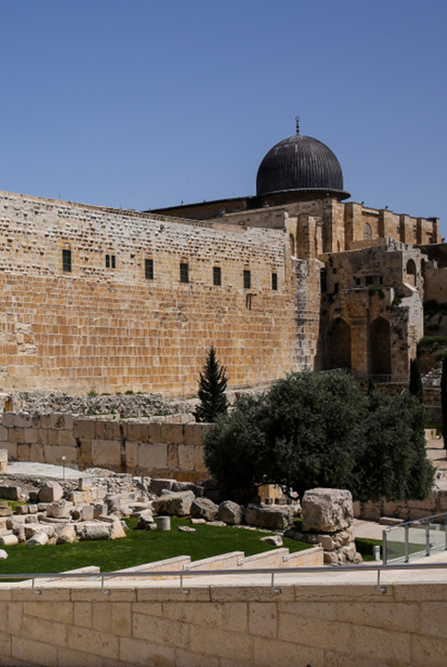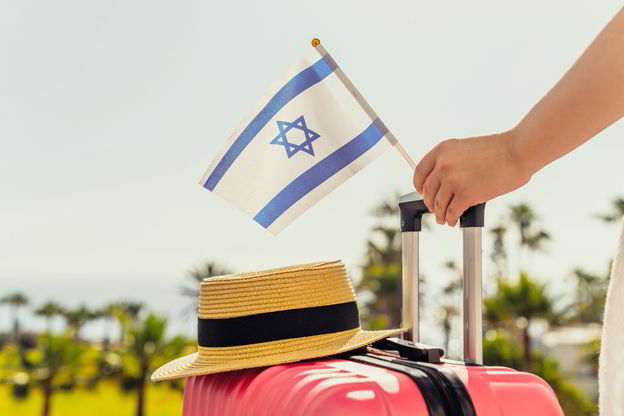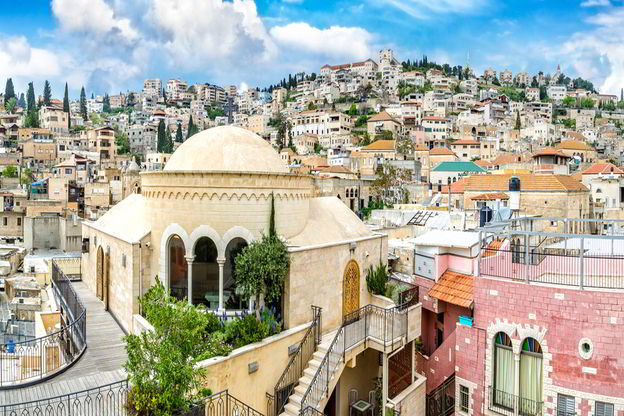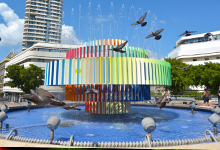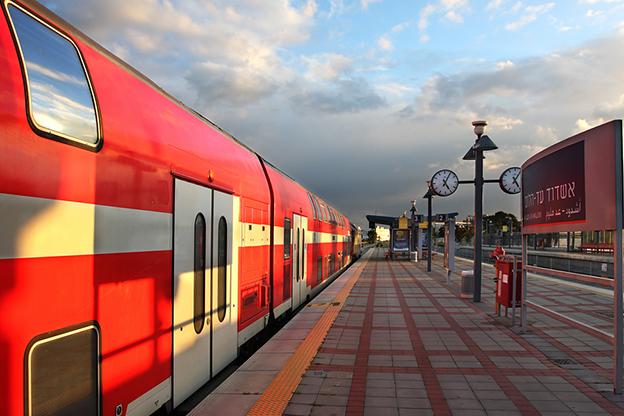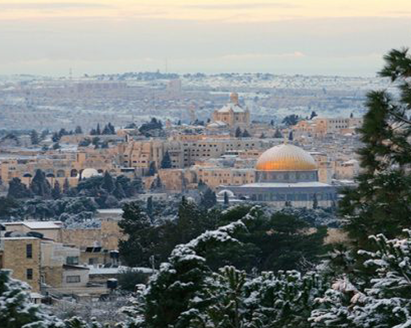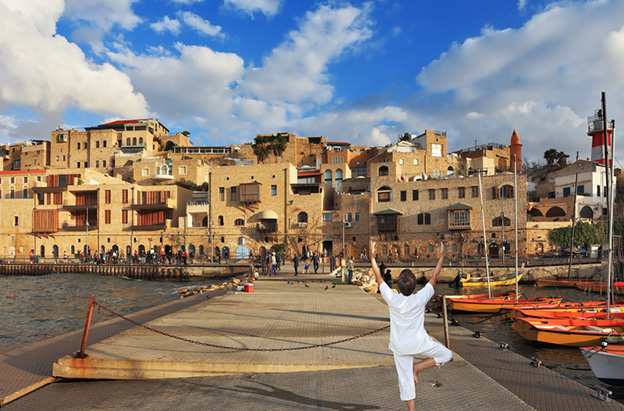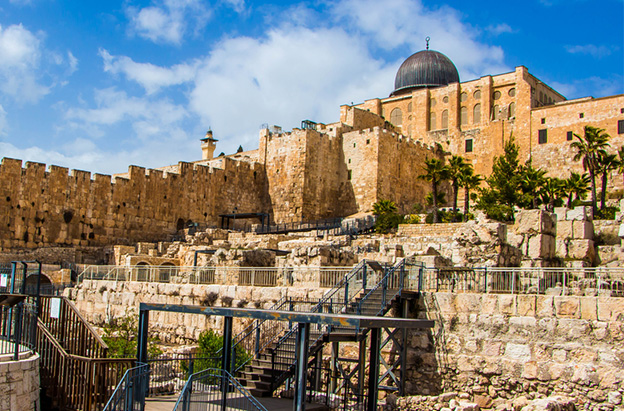It has made such an enormous impact on Western civilization that it’s hard to fathom how small Jerusalem actually once was. According to archeological evidence, over 5,000 years ago a first settlement was established near Gihon Spring, northeast of the Old City of Jerusalem. Located in the Kidron Valley, the Gihon Spring made human settlement possible in ancient Jerusalem, providing both drinking water and irrigation for the adjacent valley. It was the main source of water for the Jerusalem of King David, who captured the city from the Jebusites in the 10th century B.C.E.
Most scholars believe that David’s Jerusalem occupied a narrow hilltop strip comprising no more than 10 acres, with a population of perhaps 2,000. Today, the UNESCO World Heritage-listed Old City, though tiny, is 20 times larger – at 220 acres, while the population of greater Jerusalem today is over 1.2 million. Carrying water from the Gihon Spring on foot has long been replaced with carrying bottled water from Mahane Yehuda market on the city’s electrified Light Rail.
In 2016, excavations in Jerusalem by the Israel Antiquities Authority unearthed remains dating back 7,000 years to the start of the Copper Age. The tools, chisels and blades found are the oldest known remains and predate human settlement by 2,000 years. Jerusalem then was all copper tools for harvest time; today, it’s a growing start-up landscape and home to an Intel R&D center.
In the Old City, history quietly breathes in the background, having born witness to the passage of time gone by. Nearby, the Dan Hotels in Jerusalem exude a modern tranquility, a subtle contrast to the ancient whispers that surround them, allowing moments of quiet reflection in contemporary comfort.
The Old City’s Four Quarters make a Whole
The division of Jerusalem’s Old City into quarters took shape during the Ottoman period in the 19th century, each of the four quarters – Jewish, Christian, Armenian, and Muslim – allocated specific areas for residence and worship, reflecting the multi-religious and multicultural character of Jerusalem. While the Ottoman designations persisted, it was during the British Mandate in the early 20th century that the quarters became more defined and administratively recognized. Today, the Old City stands as a microcosm of religious and cultural diversity, with each quarter contributing to the rich tapestry of Jerusalem’s history.
The Pulse of the Jewish Quarter
Nestled within the ancient walls of Jerusalem’s Old City, the Jewish Quarter is a living testament to the enduring spirit of the Jewish people and their intricate connection to this sacred land. The Western Wall or “Kotel”, a cherished remnant of the Second Temple, stands as the heartbeat of the Jewish Quarter. Formed by massive stone blocks from the Second Jewish Temple, the Kotel is a sacred site in Jerusalem’s Old City, holding immense significance in Judaism as the closest accessible point to the Temple Mount, the former Holy of Holies location. Tourists and pilgrims flock to marvel at this spiritual and archaeological wonder, often placing written prayers in its cracks. Tour the Kotel Tunnels, whose underground passages unveil hidden sections of the Western Wall, ancient water trenches, and streets from the Second Temple period. Beyond symbolizing the Jewish connection to history, the Western Wall stands as a testament to Jerusalem’s resilience over time. The Cardo, a reconstructed Roman-era thoroughfare, invites exploration with its vibrant shops and archaeological wonders. Hidden gems include the Hurva Synagogue, a symbol of the Quarter’s resilience, having been destroyed and rebuilt multiple times. In the maze of cobblestone streets, vibrant yeshivas, and kosher eateries, one can feel the pulse of a community deeply rooted in tradition yet embracing the modern.
Fascinating Christian tapestry
The Christian Quarter is a tapestry woven with centuries of religious and historical significance. Dominated by the iconic Church of the Holy Sepulchre, a pilgrimage destination since the 4th century. Believed to enshrine the crucifixion, burial, and resurrection sites of Jesus Christ, Christians of all denominations and people from around the world can be seen visiting the church’s various frankincense laden vestibules and chambers. Just a 15-minute walk away is the Room of the Last Supper, where Jesus shared the Passover meal with his disciples, just adjacent to the Tomb of King David, a revered site for Jews. This quarter resonates with pilgrims and historians alike. Pilgrims tread the Via Dolorosa, tracing the purported path of Jesus carrying the cross. Beyond the obvious, the Ethiopian Orthodox Church has maintained a quiet presence in Jerusalem for more than 1,500 years, with some people claiming that there has been an Ethiopian delegacy in the Holy Land ever since the famed meeting of the Queen of Sheba and King Solomon some 3,000 years ago. For many centuries, the center of the Ethiopian Church in Jerusalem was a small courtyard with several structures behind the Church of the Holy Sepulcher in the Christian Quarter of the Old City. Today, however, the Church has to a large extent relocated outside the walls to the western part of the city. The Christian Quarter beckons not only as a spiritual haven but also as a living testament to Jerusalem’s intricate and enduring narrative.
3 Days in Jerusalem: A Full Itinerary for Amazing Trip >>
Vibrant emblem of Islam
The Muslim Quarter unfolds as a vibrant mosaic of culture, commerce, and profound religious heritage. The resplendent Dome of the Rock, with its golden dome piercing the skyline, stands as an emblem of Islamic architecture and is a focal point for prayer and contemplation. Completed in 691 CE, the Dome of the Rock is widely believed to be the site where the Prophet Muhammad ascended to heaven during his Night Journey, as well as the location of the Binding of Isaac in Jewish and Christian traditions. Close by is the Al Aqsa Mosque, which has been in use for more than 1,000 years, adding an air of sanctity to the Quarter, drawing worshippers and visitors alike. Venturing beyond the prominent landmarks reveals hidden gems like the bustling markets, where the aroma of spices and the kaleidoscope of goods offer a sensory feast. The Quarter’s essence lies not only in its religious sites but in the daily rhythm of life, where the call to prayer intertwines with the rhythm of market transactions.
Rich Armenian depth
The Armenian Quarter is a testament to the enduring legacy of the Armenian people, an enclave of cultural richness and historical depth. Established in the 14th century, this quarter became a refuge for Armenians fleeing persecution, evolving into a distinctive community within the city walls. It is home to the St. James Cathedral, an architectural marvel adorned with ornate decorations, and the Armenian Patriarchate, a spiritual and administrative center. The Armenian Quarter also holds the story of the Armenian Genocide, with monuments like the Genocide Memorial commemorating the victims. The Armenian presence in Jerusalem is not just a cultural enclave but a resilient chapter in history, commemorated through sacred sites and memorials that speak to the strength and endurance of a people who found solace and continuity within the Old City’s walls.
Best views over the city
There are some terrific observation points over the Old City. The Austrian Hospice offers one. Make your way through the Old City to this old pilgrim hostel of the Austrian Catholic Church, located at the corner of Via Dolorosa and El-Wad Street in the Muslim Quarter. Head upstairs to forget the rooftop panorama from the 4th floor viewing platform, before treating yourself downstairs to the famous apple strudel and iced teas at the renowned Austrian café. Also, inside the Old City of Jerusalem, near Jaffa gate, you can find the Tower of David, which offers a great lookout over the city, as does the Ramparts Walk, which offers two paths overseeing the Old City. Starting near Jaffa Gate, these routes have many stairs and narrow places so are unsuitable for people with disabilities, as well as those with strollers.
Old City of Jerusalem: Best places to stay
Getting to the Old City depends on where you are. Of the hotels in Jerusalem near the Old City, staying at the Dan Hotels gives you an advantage, both from the convenience of their locations and their first-rate comfort. The King David Jerusalem Hotel is superbly located at the meeting point of the Old City and dynamic New Jerusalem, just a 15-minute walk from the Old City, home to the above landmarks. Sitting on the historic slopes of Mount Scopus, overlooking the famous Jerusalem skyline and the rolling Judean Hills,
the Dan Jerusalem Hotel is located minutes from the efficient, smooth and regular Jerusalem Light Rail that will take you swiftly to the Old City, while a scenic stroll from the Dan Panorama Jerusalem takes you to the Old City, while the Dan Boutique Jerusalem is situated in a prime Jerusalem setting, facing the historic Mount Zion, the original City of David on a hill just outside the Old City walls. When inside the Old City, it is all walkable so take comfortable shoes and go early morning or late afternoon to avoid huge crowds, but patience and a slow pace is key.
A visit to Jerusalem’s Old City will transport you back to a world gone by, offering you an unmatched experience to chronicle its extraordinary voyage, from a small unremarkable spring to a city named Jerusalem.

